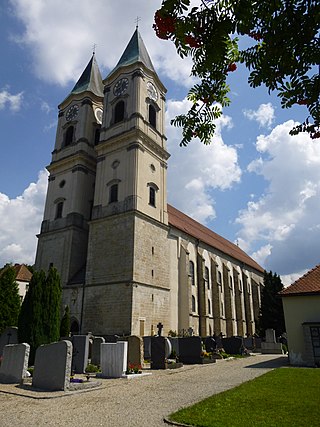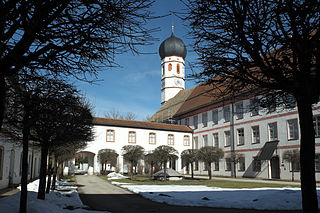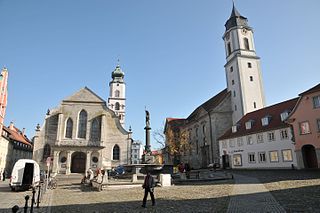
Herrenchiemsee is a complex of royal buildings on Herreninsel, the largest island in the Chiemsee lake, in southern Bavaria, Germany. Together with the neighbouring isle of Frauenchiemsee and the uninhabited Krautinsel, it forms the municipality of Chiemsee, located about 60 kilometres (37 mi) southeast of Munich.

Ettal Abbey is a Benedictine monastery in the village of Ettal close to Oberammergau and Garmisch-Partenkirchen in Bavaria, Germany. With a community of more than 50 monks, with another five at Wechselburg, the Abbey is one of the largest Benedictine houses and is a major attraction for visitors.

Tegernsee Abbey is a former Benedictine monastery in the town and district of Tegernsee in Bavaria. Both the abbey and the town that grew up around it are named after the Tegernsee, the lake on the shores of which they are located. The name is from the Old High German tegarin seo, meaning great lake.

Wessobrunn Abbey was a Benedictine monastery near Weilheim in Bavaria, Germany.

Irsee Abbey, also the Imperial Abbey of Irsee, was a Benedictine abbey located at Irsee near Kaufbeuren in Bavaria. The self-ruling imperial abbey was secularized in the course of the German mediatization of 1802–1803 and its territory annexed to Bavaria. The buildings of the former abbey now house a conference and training centre for Bavarian Swabia.

Scheyern Abbey, formerly also Scheyern Priory, is a house of the Benedictine Order in Scheyern in Bavaria.

Niederaltaich Abbey is a house of the Benedictine Order founded in 741, situated in the village of Niederalteich on the Danube in Bavaria.

Benediktbeuern Abbey is an institute of the Salesians of Don Bosco, originally a monastery of the Benedictine Order, in Benediktbeuern in Bavaria, near the Kochelsee, 64 km south-south-west of Munich. It is the oldest and one of the most beautiful monasteries in Upper Bavaria. It was badly damaged in an extreme weather event in 2023.

Neresheim Abbey or the Abbey of Saints Ulrich and Afra, Neresheim is located above the town of Neresheim in Baden-Württemberg, southern Germany. It is now a Benedictine monastery and is part of the Beuronese Congregation.

Maredsous Abbey is a Benedictine monastery at Maredsous, in the municipality of Anhée, Wallonia, Belgium. It is a founding member of the Annunciation Congregation of the Benedictine Confederation.

Beuerberg Abbey, formerly a monastery of the Augustinian Canons, is now the Monastery of the Visitation, Beuerberg, a community of the Visitandines in Eurasburg in Bavaria, Germany.

Schäftlarn Abbey is a Benedictine monastery on the Isar in Schäftlarn, south of Munich in Bavaria, Germany.

Mondsee Abbey was a Benedictine monastery in Mondsee in Upper Austria.

Steingaden Abbey was a Premonstratensian monastery in Steingaden in Bavaria, Germany.

St. Georgenberg Abbey is a Benedictine monastery, the oldest extant monastery in the Tyrol, founded in 1138 but from 1708 to 2019 removed to the nearby city of Fiecht in the community of Vomp in Tyrol, Austria. In 2019 the monks returned to a restored abbey at St. Georgenberg, which had remained a place of pilgrimage and spiritual retreat.

Silvacane Abbey is a former Cistercian monastery in the municipality of La Roque-d'Anthéron, Bouches-du-Rhône, in Provence, France. It was founded in or around 1144 as a daughter house of Morimond Abbey and was dissolved in 1443; it ceased to be an ecclesiastical property in the French Revolution. The church was acquired by the French state in 1846, the remaining buildings not until 1949. It is one of the three Cistercian abbeys in Provence known as the "three sisters of Provence", the other two being Sénanque Abbey and Le Thoronet Abbey; Silvacane was possibly the last-established.

Rottenbuch is a municipality in the Weilheim-Schongau district, in Bavaria, Germany. It is the site of Rottenbuch Abbey church. Its name stems from a beech tree clearing; it is common in Germany to find place names based on tree clearings. The first historical mention appears in 1073 when Welf I gifts the by then already built Augustinian monastery large lands on both sides of the Ammer river. Supposedly, since around 950, some "Einsiedler" (hermits/ascetics) were already living in Rottenbuch together and following a monastic way of life.

Lindau Abbey was a house of secular canonesses in Lindau on the Bodensee in Bavaria, Germany, which stands on an island in the lake.

St. John's Abbey in the Thurtal was a Benedictine monastery originally established in Alt St. Johann in the Canton of St. Gallen, Switzerland, in the mid-12th century.

Rein Abbey is a Cistercian monastery in Rein near Gratwein, Styria, in Austria. Also known as the "Cradle of Styria", it is the oldest surviving Cistercian community in the world.





















